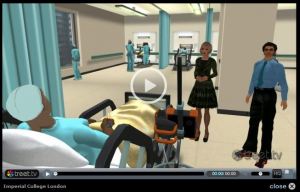Imperial College London | Treet TV.
Imagine making a live TV show with a bunch of potentially maverick scientists and a studio audience. Nervous? Good. Now imagine that you’re going to do this in a virtual world with all your presenters and guests represented as avatars and communicating using text, in-world voice, and VOIP. Not to mention you need them to face front at the right time, have in-world voice turned on but not up so you get lip sync without echo, and nobody’s connection cracks up. That’s the challenge faced by the Treet TV team that followed Dave Taylor, Robin Winter and me through the various sets in which medical training, research and development takes place in Second Life.
I am not at all sure what I had expected and, as all of this kind of interaction often takes place in one’s own very familiar environment at home, there is always the risk of being slightly ‘off duty’, as it were and forgetting that you need to sit up straight and pay attention. In my case, I had to get rid of the sheep helicopter that had followed me from an earlier steam punk exhibition and stop the cat purring into my microphone. I should also have ditched the hat and remembered to park my cursor so that my avatar held her head up instead of peering intently into an invisible gutter.
Clearly, marshalling amateurs like us is what this team does supremely well although at least one of us, (Mr Taylor, mentioning no names), had to be constrained to stop rushing around and just please stand still. Of course it was essentially the Imperial College Show and the build and animations designed and produced by Dave and Robin, the in-house 3D designer, were the stars. I have known about this work for some time but even so, I was astonished at the complexity of the models and interactivity available to trainee doctors and nurses in these realistic environments. In theatre, we looked at the workings of intricate positioning equipment for different operations as Robin ran through the animations and, on a ward, we saw the trail of information designed to alert nursing staff to developing risks.
Later, Dave demonstrated a patient examination animation in which lab tests could be ordered and treatment applied after palpating the patient’s abdomen. The chap even demanded water after perking up with his newly applied salbutamol nebuliser although this is plainly unrealistic. In my experience as a nurse it was always the loo they needed just as you got them kitted out with their tubes and lines. Maybe in the next iteration!
applied after palpating the patient’s abdomen. The chap even demanded water after perking up with his newly applied salbutamol nebuliser although this is plainly unrealistic. In my experience as a nurse it was always the loo they needed just as you got them kitted out with their tubes and lines. Maybe in the next iteration!
Meanwhile, I was hanging about, microphone muted so as not to introduce spurious and alarming domestic noises, outside the waiting room of the Royal Sussex County where we had run our study on consent last year. That was where I discovered I was still carrying my sonic screwdriver and also where I realised just how difficult it is to be spontaneous to order. Thank goodness my avatar was handling the hair, makeup and motion end of things or I would probably have tangled my feet, walked into the lamppost and delivered a glassy spinach-in-the-teeth beam to the air. Instead of which, my hat hid most of me while I examined the pavement in minute detail then walked sideways into the door frame.
Once successfully indoors, Saffia Widdershins and I did the tour of the examination room, operating theatre, and recovery room  where we had taken twenty adults with learning disabilities in late 2009. This was an unscripted Q&A guided only by our run-through earlier in the evening. I should not have been surprised at how elements of our casual conversation were woven into that scene to give the impression of a planned interview. That’s professionalism.
where we had taken twenty adults with learning disabilities in late 2009. This was an unscripted Q&A guided only by our run-through earlier in the evening. I should not have been surprised at how elements of our casual conversation were woven into that scene to give the impression of a planned interview. That’s professionalism.
Today, seeing the final product (see link above), I was struck by how much less ‘real’ it seemed as video than it had at the time and that, precisely, is the value of an immersive interactive virtual environment. However good a video presentation, and this is a remarkable production for so many reasons, it does not have the sense of co-presence, the personal volition, the capacity to change at will one’s perspective or some element of the environment. It does not involve because it is passive. Virtual technology is active, allows for change, capitalises on the social psychology of human interaction, and is responsive to the presence of its inhabitants. That’s why we use it for research, for training, for development of human services, and for management of risk.
That and the sheep helicopters.

